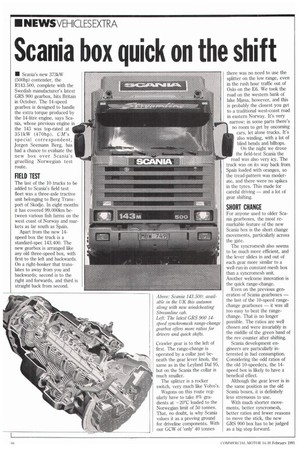Scania box quick on the shift
Page 12

If you've noticed an error in this article please click here to report it so we can fix it.
• Scania's new 373kW (500hp) contender, the R143.500, complete with the Swedish manufacturer's latest GRS 900 gearbox, hits Britain in October. The 14-speed gearbox is designed to handle the extra torque produced by the 14-litre engine, says Scania, whose previous engine in the 143 was top-rated at 351kW (470hp). CM's special correspondent, Jorgen Seemann Berg, has had a chance to evaluate the new box over Scania's gruelling Norwegian test route.
FIELD TEST
The last of the 10 trucks to be added to Scania's field test fleet was a three-axle tractive unit belonging to Berg Transport of Skodje. In eight months it has covered 99,000km between various fish farms on the west coast of Norway and markets as far south as Spain.
Apart from the new 14speed box the truck is a standard-spec 143.400. The new gearbox is arranged like any old three-speed box, with first to the left and backwards. On a right-hooker that translates to away from you and backwards; second is to the right and forwards, and third is straight back from second. Crawler gear is to the left of first. The range-change is operated by a collar just beneath the gear lever knob, the same as in the Leyland Daf 95, but on the Scania the collar is much smaller.
The splitter is a rocker switch, very much like Volvo's.
Wagons on this route regularly have to take 8% gradients at —20°C loaded to the Norwegian limit of 50 tonnes. That, no doubt, is why Scalia values it as a proving ground for driveline components. With our GCW of only' 40 tonnes there was no need to use the splitter on the low range, even in the rush hour traffic out of Oslo on the Ea We took the road on the western bank of lake Mjosa, however, and this is probably the closest you get to a traditional west-coast road in eastern Norway. It's very narrow: in some parts there's no room to get by oncoming cars, let alone trucks. It's also winding, with a lot of blind bends and hilltops.
On the night we drove the field-test Scania the road was also very icy. The truck was on its way back from Spain loaded with oranges, so the tread-pattern was moderate, and there were no spikes in the tyres. This made for careful driving — and a lot of gear shifting.
SHORT CHANGE
For anyone used to older Scania gearboxes, the most remarkable feature of the new Scania box is the short change movements, particularly across the gate.
The syncromesh also seems to be much more efficient, and the lever slides in and out of each gear more similar to a well-run-in constant-mesh box than a syncromesh unit. Another welcome innovation is the quick range-change.
Even on the previous generation of Scania gearboxes — the last of the 10-speed rangechange gearboxes — it was all too easy to beat the rangechange. That is no longer possible. The ratios are well chosen and were invariably in the middle of the green band of the rev counter after shifting.
Scania development engineers are particularly interested in fuel consumption. Considering the odd ratios of the old 10-speeders, the 14speed box is likely to have a benefical effect.
Although the gear lever is in the same position as the old Scania boxes, it is definitely less strenuous to use.
With much shorter movements, better syncromesh, better ratios and fewer reasons to move the stick, the new GRS 900 box has to be judged as a big step forward.








































































































